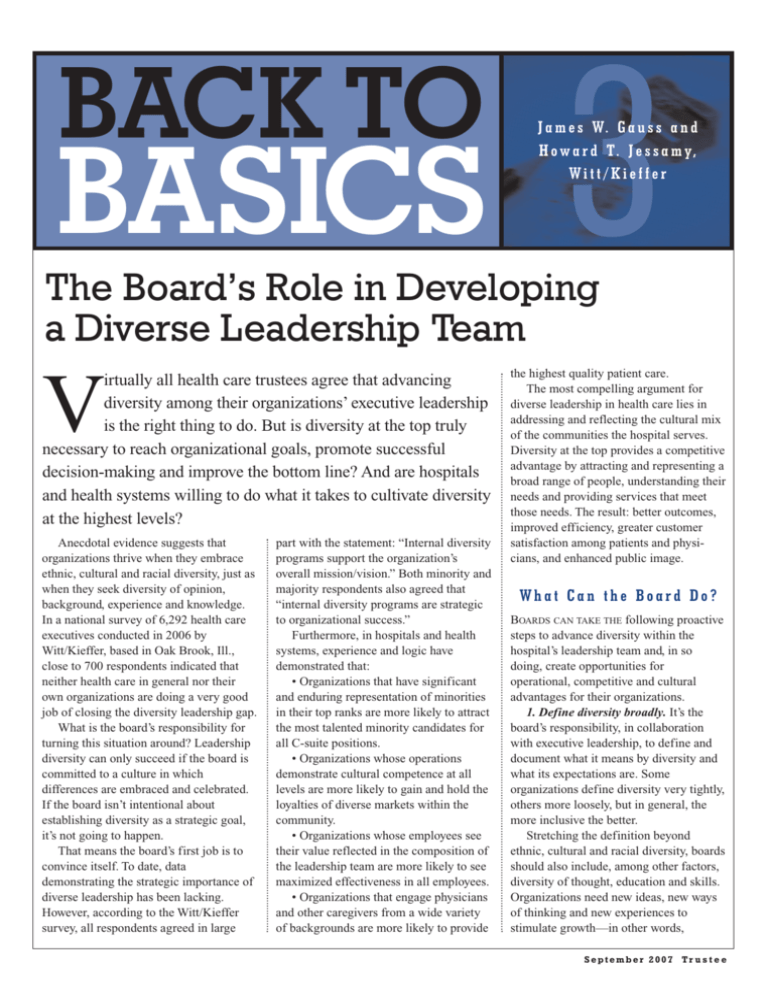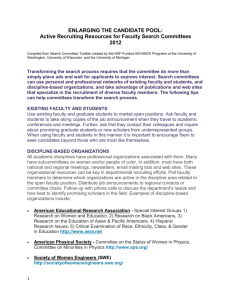The Board's Role in Developing a Diverse Leadership
advertisement

BACK TO BASICS 3 J a m e s W. G a u s s a n d H o w a r d T. J e s s a m y, Witt/Kieffer The Board’s Role in Developing a Diverse Leadership Team irtually all health care trustees agree that advancing diversity among their organizations’ executive leadership is the right thing to do. But is diversity at the top truly necessary to reach organizational goals, promote successful decision-making and improve the bottom line? And are hospitals and health systems willing to do what it takes to cultivate diversity at the highest levels? V Anecdotal evidence suggests that organizations thrive when they embrace ethnic, cultural and racial diversity, just as when they seek diversity of opinion, background, experience and knowledge. In a national survey of 6,292 health care executives conducted in 2006 by Witt/Kieffer, based in Oak Brook, Ill., close to 700 respondents indicated that neither health care in general nor their own organizations are doing a very good job of closing the diversity leadership gap. What is the board’s responsibility for turning this situation around? Leadership diversity can only succeed if the board is committed to a culture in which differences are embraced and celebrated. If the board isn’t intentional about establishing diversity as a strategic goal, it’s not going to happen. That means the board’s first job is to convince itself. To date, data demonstrating the strategic importance of diverse leadership has been lacking. However, according to the Witt/Kieffer survey, all respondents agreed in large part with the statement: “Internal diversity programs support the organization’s overall mission/vision.” Both minority and majority respondents also agreed that “internal diversity programs are strategic to organizational success.” Furthermore, in hospitals and health systems, experience and logic have demonstrated that: • Organizations that have significant and enduring representation of minorities in their top ranks are more likely to attract the most talented minority candidates for all C-suite positions. • Organizations whose operations demonstrate cultural competence at all levels are more likely to gain and hold the loyalties of diverse markets within the community. • Organizations whose employees see their value reflected in the composition of the leadership team are more likely to see maximized effectiveness in all employees. • Organizations that engage physicians and other caregivers from a wide variety of backgrounds are more likely to provide the highest quality patient care. The most compelling argument for diverse leadership in health care lies in addressing and reflecting the cultural mix of the communities the hospital serves. Diversity at the top provides a competitive advantage by attracting and representing a broad range of people, understanding their needs and providing services that meet those needs. The result: better outcomes, improved efficiency, greater customer satisfaction among patients and physicians, and enhanced public image. What Can the Board Do? BOARDS CAN TAKE THE following proactive steps to advance diversity within the hospital’s leadership team and, in so doing, create opportunities for operational, competitive and cultural advantages for their organizations. 1. Define diversity broadly. It’s the board’s responsibility, in collaboration with executive leadership, to define and document what it means by diversity and what its expectations are. Some organizations define diversity very tightly, others more loosely, but in general, the more inclusive the better. Stretching the definition beyond ethnic, cultural and racial diversity, boards should also include, among other factors, diversity of thought, education and skills. Organizations need new ideas, new ways of thinking and new experiences to stimulate growth—in other words, September 2007 Tr u s t e e diversity that goes well beyond ethnicity. So, while Equal Employment Opportunity Commission guidelines may provide a starting place for defining diversity, the board should go further and ask itself questions such as: • What is cultural competence? Is it the ability of each individual to understand and relate effectively to people from a wide variety of backgrounds? Is it broader? Does it encompass how teams of people work together? Does it relate to how organizations function? Does it drive patient satisfaction? Physician satisfaction? Employee satisfaction? • What is the specific goal of a diversity initiative? Is it primarily about recruitment and retention? Should the entire organization reflect the general makeup of the community? • How do community members define themselves? For example, does “Hispanic” mean Mexican-American, Puerto Rican or Dominican in the area? • What about leadership within the hospital or system? Should diversity be a goal within each department? Among department heads? Within the C-suite? Should diversity improvement be focused only at the system/corporate level, and/or should it also include each entity within a system? • What about communities that lack racial diversity? Is it up to the health care organization to introduce new ethnic and cultural elements that will enrich how it functions? • What about other definitions of diversity? Should a certain percentage of the executive team be women? Different ages? Should some have a background in public or tax-paying hospitals and some come from the traditional nonprofit sector? What about Southerners in the North and Northerners in the South? 2. Make diverse leadership a strategic priority for the organization. It’s up to the board to ensure that diversity is a strategic imperative, that the board and executive leadership are in sync on the issue, and that senior leaders are responsible and accountable for promoting diversity throughout the organization. The board’s role in achieving diversity must be clearly defined in collaboration with the CEO. Boards should be aware that some CEOs will welcome their Tr u s t e e September 2007 expertise in this area, while others may not. The key to success is for the board to maintain the proper balance between being too passive or too aggressive on advancing diversity leadership. While the CEO is typically the only executive the board hires, it can influence other hiring decisions and increase the odds of success in minority recruitment and retention by keeping diversity a strategic priority. This may include pursuing any or all of these activities: • Make diversity a subject that the board regularly discusses; consider forming a committee for the purpose. he board can influence hiring decisions and increase the odds of success in minority recruitment and retention by keeping diversity a strategic priority. T • Insist that cultural sensitivity to patients and employees be an organization standard. • Work to ensure that diversity training for all employees is comprehensive, ongoing and organizationwide. • Set diversity leadership objectives and guidelines for the CEO to implement within specific time frames and require periodic progress reports. • Make progress toward diversity leadership goals a part of the CEO’s performance evaluation. • Tie a small portion of executive compensation to how well the organization is meeting diversity goals and objectives. • Make experience in creating an inclusive work environment, including advancing diversity leadership, a criterion for hiring a CEO. • Encourage the dissemination of information about diversity programs and opportunities to employees at all levels of the organization. • Encourage the development of organizational policies that foster employee inclusion in all types of work groups, including forums, advisory committees and performance improvement task forces. • Ask for regular reports on the organization’s readiness to accept diversity, as measured by such indicators as retention of minority staff, surveys of employee attitudes, diversity training hours and representation of people with diverse backgrounds in key functions and on key committees. • Ask for debriefings following the loss of a minority executive to explore what, if anything, went wrong. 3. Learn about the possibilities and pitfalls in diversity recruiting and retention. Other industries are ahead of health care when it comes to implementing and documenting diversity programs at the executive level. Success stories from Hewlett-Packard and IBM, among others, offer models and benchmarks that health care organizations can readily adapt for their own purposes. Similarly, there are health care organizations in all parts of the country that have become magnets for minority talent by taking the steps described here. Faith-based health care providers in particular often make cultural competence a priority as an extension of their mission, and place a high value on diverse leadership. Boards should take every opportunity to learn from the best practices of these organizations. Furthermore, boards also can look inward for more lessons from their organizations. They should analyze the experience of their own diverse executives to find out: • What are their backgrounds? • Have they been able to succeed? • How long has each stayed with the organization? • Of those who have left, what were the reasons? • Was their tenure positive or troubled? Why? • Did they encounter any systemic or personal prejudice? If so, did the organization confront the problem directly? Boards also should be knowledgeable about the demographics of their hospitals and service areas to gauge how closely they align. In most metropolitan and suburban areas, ethnic and cultural minorities are likely to be overrepresented among service workers and underrepresented at the department head level and above. At the same time, the patient population may have changed significantly in recent years. In many previously white-dominated neighborhoods of New York, Chicago and Los Angeles, for example, minorities now constitute the majority. Understanding the demographics of the community allows the board to set realistic goals and objectives for diversity. 4. Make diversity a part of formal succession planning and mentoring processes. The organizations that are most successful in recruiting and retaining talented minorities combine a commitment to an inclusive work environment with effective succession planning and mentoring. In its simplest form, succession planning gives people opportunities to grow. But our research shows that many hospitals and health systems have yet to make adequate plans for the succession and development of their leaders. Notwithstanding, there is growing interest in formal mentoring programs because they represent one of the most powerful tools an organization has for grooming future members of the C-suite. Large organizations have more resources to dedicate to this function, but even the smallest hospitals can and should take promising internal candidates under their wing. In collaboration with its CEO, the board should drive the succession planning process and ensure that diversity is a key component. The board must understand that as the talent war heats up in health care, more and more organizations will need to look inside for promising leaders. Savvy scouting for future leaders is fine, but it doesn’t go far enough. Hospitals and health systems need a talented “farm team” of up-and-comers in middle and upper management from which to draw. Boards are responsible for making sure the hospital or system succession plan includes both formal and informal mentoring, particularly for minorities who may not have had similar relationships before, largely because they have not had the same opportunities to be in settings and/or positions to benefit from such guidance. Formal mentoring usually involves extensive written descriptions of training and development programs and regular evaluations of these programs to make sure they are achieving their objectives. However, informal mentoring may provide many of the same experiences without the rigorous metrics. Regardless, it is a good idea for mentors and mentees to get together at least quarterly to review progress on developmental goals, asking themselves: • What kind of exposures and experiences does the person need to have next and is he or she getting them? • Which new skills will the person need to master and where are they best acquired? • What institutional knowledge is the person missing and who can best supply it? • Where are opportunities, inside and outside the organization, for the person to practice leadership skills? While such mentoring can be critical to the success of people of color, since it may be the first time they have had an opportunity to benefit from the coaching and mentoring that is often more available to whites, cultural competence requires that leadership development is both inclusive and far-reaching. The board’s role is to insist on accountability with respect to committed and ongoing efforts to cultivate leaders from within. Otherwise, the board may find its hospital or health system is losing ground in the talent war. 5. Mandate diverse slates for leadership positions. Boards should mandate that candidate slates for all leadership positions include diverse candidates. Doing so will demonstrate that the board and senior leadership are serious about diversity recruitment. Board members also may suggest sources for finding qualified candidates, such as historically black colleges and universities with MHA and MBA programs, as well as encouraging Best Practices in Recruitment and Retention Health care leaders who responded to the Witt/Kieffer executive search survey recommended the following best practices for attracting diverse C-suite candidates: • Sensitize management to diversity needs. • Target diversity leadership as a strategic goal. • Develop cultural sensitivity initiatives and strategies. • Examine cultural disparities among leadership positions and medical staff. • Communicate diversity initiatives to all employees. • Communicate the value of cultural differences. • Promote minorities from within the organization. • Hire minority executives for management jobs. • Identify internal “champions” who value cultural differences. • Seek out minority candidates from professional organizations. • Develop relationships with executive search firms that are committed to diversity. • Mentor employees. • Establish a specific, targeted diversity recruiting program. representative segments of the community to offer their own suggestions. Similarly, board members, along with physicians and executives, can and should network with diversity leadership organizations. This may include getting involved in professional associations such as the Institute for Diversity in Health Management and the National Association of Health Services Executives, as well as attending minority-based conferences and events. Finally, the board has direct responsibility for hiring a new CEO. In that vein, it should make certain that the search committee is up to the task of identifying and evaluating diverse candidates. If need be, the search committee should consider using a search September 2007 Tr u s t e e firm and/or including representatives who are knowledgeable about minority talent—where to find it, how to nourish it—as part of the search process. At a minimum, boards should require that leadership searches cast a wide net and feature a diverse range of candidates according to its definition of diversity. 6. Provide opportunities for minority leaders to gain exposure to the workings of the board. Executives making their way up through the organizational ranks need to understand how boards function. Many, however, get little if any board exposure. Future leaders need to know how to work with the board, be comfortable with trustees and understand governance responsibilities. None of this will take place unless the board makes it happen, either as part of the organization’s succession plan and/or on an ad hoc basis. CEOs may want to consider inviting upand-comers to: • Attend board meetings to learn about board processes, orientation and training • Make presentations to the board on critical issues • Become staff participants in board committees • Participate in board discussions on diversity. A freestanding hospital board might rotate extending meeting invitations to a small cadre of executives headed for the C-suite, as opposed to the workings of a large system, where only the CEOs from individual hospitals are likely to receive similar invitations. However, a system board might encourage other C-suite leaders to gain board experience by serving on the boards of not-for-profit organizations in the community. What’s Standing in the Wa y ? From the perspective of minority executives who responded to the Witt/Kieffer survey, the leading barrier to diversity recruitment and retention in the highest ranks is lack of commitment—from top management, the board and human resources. Nonminority executive respondents to the survey agreed that lack of commitment by top management is a key factor, but even more importantly, Tr u s t e e September 2007 they say, is the lack of diverse candidates inside and outside the organization. Evidence suggests that both groups are correct, so forward-thinking boards will want to attack the problem on both fronts. To address a lack of commitment from governance and leadership, the board should start by turning a critical eye on its intentional about reaching into professional associations, societies and other organizations geared to minorities in existing leadership roles. In the long run, hospitals need to develop programs that attract high school students to health care and internships or fellowships that appeal to business and MHA graduate students any hospitals in geographically isolated communities find it extremely difficult to attract talented minorities. M own composition. It’s hard to address diversity in executive leadership ranks unless there are a variety of perspectives represented on the board. According to a recent survey by the Hospital Research & Educational Trust of the American Hospital Association, the average hospital board comprises 13 members, of which 13 percent are women and 9 percent are nonCaucasian. On the other hand, some health care organizations have much more diverse representation on the board than in the Csuite. Community representation is the foundation on which most health care boards have been built. However, there may be reluctance on the part of minority board members to make the issue of diversity a part of their personal agenda. To counter this, boards can seek out training on the value of diversity for the entire group and encourage minority board members to share their knowledge, experience and perspectives. Boards also need to work with the CEO and human resources executives to make sure the organization’s plan to achieve cultural competence is easily articulated, widely shared and measurable. Regular reports on the plan’s progress demonstrate to the organization as a whole, and minorities in particular, that diversity leadership is among the hospital’s top priorities. To address concerns about a lack of minority candidates, the board must establish that it expects senior management to look hard to find them. In the short term, hospitals must be considering careers in health care administration. Meanwhile, many hospitals in geographically isolated communities find it extremely difficult to attract talented minorities. Indeed, in some areas, more or less homogenous leadership may accurately reflect the makeup of the community. Location is a major consideration for all job candidates but it can loom especially large for ethnic and cultural minorities. One thing a board can do in such a situation is to help the hospital pull together a well-rounded picture of the community that speaks to candidates’ concerns and interests, in addition to race or religion—good schools, community activities, affordable housing, etc. The truth is that some communities have more to offer people of diverse ethnicity than others. Yet all communities can benefit from greater racial, cultural and ethnic diversity, as well as diversity of thought, experience and background. Clearly, the board cannot and should not act in isolation. But where current leadership may be distracted from pursuing the goal of diversity at the top— due at least in part to a wide range of other organizational pressures—board members can exercise considerable influence in the following ways: by making the case for diversity as a competitive advantage; by insisting on an inclusive work environment; and by encouraging, educating, suggesting, inspiring and leading the way. In short, by doing the right thing.







